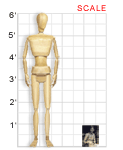VAM galleries including this work:
Berea College | Go Figure | Art Through Time || VAM Home
Doris Ulmann (New York, 1882-1934)
AUNT SOPHIE CAMPBELL, PIPES, 1930s
Platinum print
By permission of Berea College, 811
Doris Ulmann is best known for her photographs of the people of the rural South, which document their folk art and traditional crafts in sensitive portraits. Her respect for her sitters is apparent in works like Aunt Sophie Campbell, Pipes. Ulmann had an uncanny ability to capture beauty in nearly every photograph she took, and Aunt Sophie is no exception. This arresting image imbues the aged Aunt Sophie with an almost palpable air of dignity and wisdom.
Most of the Doris Ulmann images in Berea College’s Appalachian exhibits were made during the summers of 1933-34. They were among more than 3,000 images of people, crafts, and landscapes taken to illustrate Allen Eaton’s landmark book on crafts, Handicrafts of the Southern Highlands.
About the Artist
Born and raised in New York City, Doris Ulmann attended the socially progressive Ethical Culture School, which may have contributed to her interest in the peripheral cultures of the rural South and reinforced her belief in the value of the individual, regardless of ethnicity or social status. Ulmann continued her studies at Columbia University and later at the Clarence H. White School of Photography. While in New York, she made portraits of a number of famous sitters, including Albert Einstein, President Calvin Coolidge, Martha Graham, and William Butler Yeats.
But Ulmann was more interested in less famous sitters, particularly the mountain people of Appalachia and the Gullahs of the Sea Islands. She spent a great deal of time working in these areas during the 1920s and ’30s. Between 1928 and 1934, she traveled with musician, actor, and folklorist John Jacob Niles on what he called “folklore and photographic expeditions” through the Southern Highlands of Appalachia, taking thousands of photographs and creating the largest photographic record of the region ever undertaken.
Classroom Ideas
Discussion: What are some other examples of photographic portraits? Study the photograph of Aunt Sophie and other portraits by Doris Ulmann. How do her photographs differ from, say, school portraits? Study the facial expressions, body language, settings, and other details in each Ulmann image. What might the artist have wanted to communicate with each image? What do you think makes her work so powerful and timeless? Do you think her work is more documentary or artistic in its approach? Why?
Activity: Doris Ulmann’s photographs document a people, a time, and a way of life. Select a member of your family, a close friend, or someone who represents something you think is worth documenting and preserving. Using a digital or instant camera, take a selection of photographs of that person and build a photographic essay that documents your subject’s way of life, interests, and/or talents. If you don’t have a camera, use a black and white medium such as pen and ink, charcoal, or pencil to create a similar series of drawings.
Links
Find out more about Doris Ulmann and view images of her work at these locations:
- University of Oregon Libraries
[libweb.uoregon.edu/catdept/digcol/ulmann/] - Appalachia Through Doris Ulmann’s Eyes, an exhibit at Berea College
[www.berea.edu/galleryV/DorisUlmannHome.html] - Getty Museum
[www.getty.edu/art/collections/bio/a1603-1.html]

